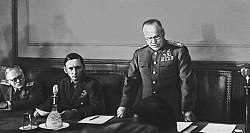| Revision as of 03:10, 13 May 2008 editEaefremov (talk | contribs)Rollbackers3,944 edits rm or← Previous edit | Revision as of 23:17, 23 May 2008 edit undoBeatle Fab Four (talk | contribs)709 edits no it don't →CelebrationNext edit → | ||
| Line 19: | Line 19: | ||
| The ] Victory Day is celebrated in most of the successor states to the Soviet Union, especially in ], ] and ]. The day is traditionally marked by ceremonial military ]s with the most prominent one being traditionally held in ] on the ]. | The ] Victory Day is celebrated in most of the successor states to the Soviet Union, especially in ], ] and ]. The day is traditionally marked by ceremonial military ]s with the most prominent one being traditionally held in ] on the ]. | ||
| The anniversary was celebrated not only in the Soviet Union but also in the countries of the ]. Since the ] these countries recognize ] instead on ] |
The anniversary was celebrated not only in the Soviet Union but also in the countries of the ]. Since the ] these countries recognize ] instead on ]. | ||
| == See also == | == See also == | ||
Revision as of 23:17, 23 May 2008
- For the song, see Den Pobedy
Victory Day marks the capitulation of Nazi Germany to the Soviet Union in the Second World War commonly referred to in the Soviet Union as the Great Patriotic War. This capitulation was signed late in the evening on May 8, 1945 (May 9 in the Moscow time zone), following the original capitulation Germany signed earlier to the joint Allied forces. The Soviet government announced the victory early on May 9 after the signing ceremony in Berlin.

History
Two separate capitulation events took place at the time. First, the capitulation to the Allied nations in Reims was signed on May 7, 1945, effective 23:01 CET May 8. This date is commonly referred to as the V-E Day (Victory in Europe Day) in most western European countries.
However, the Soviet Union's only representative in Reims was General Ivan Susloparov, the Military Liaison Mission Commander. General Susloparov's scope of authority was not entirely clear, and he had no means of immediate contact with the Kremlin, but nevertheless decided to sign for the Soviet side. Susloparov was caught off guard; he had no instructions from Moscow. But if he did not sign, he risked a German surrender without Soviet participation. However, he noted that it could be replaced with a new version in the future. Stalin was later displeased by these events, believing that the German surrender should have been accepted only by the envoy of the USSR Supreme command and signed only in Berlin and insisted the Reims protocol be considered preliminary, with the main ceremony to be held in Berlin, where Marshal Zhukov was at the time, as the latter recounts in his memoirs:
Today, in Reims, Germans signed the preliminary act on an unconditional surrender. The main contribution, however, was done by Soviet people and not by the Allies, therefore the capitulation must be signed in front of the Supreme Command of all countries of the anti-Hitler coalition, and not only in front of the Supreme Command of Allied Forces. Moreover, I disagree that the surrender was not signed in Berlin, which was the center of Nazi aggression. We agreed with the Allies to consider the Reims protocol as preliminary.

Therefore, another ceremony was organized in a surviving manor in the outskirts of Berlin late on May 8, when it was already May 9 in Moscow due to the difference in time zones. Field-Marshal Wilhelm Keitel submitted the capitulation of the Wehrmacht to the Soviet Marshal Georgy Zhukov in the Red Army headquarters in Berlin-Karlshorst. To commemorate the victory in the war, the ceremonial Moscow Victory Parade was held in the Soviet capital on June 24, 1945.
Celebration
The May 9 Victory Day is celebrated in most of the successor states to the Soviet Union, especially in Russia, Ukraine and Belarus. The day is traditionally marked by ceremonial military parades with the most prominent one being traditionally held in Moscow on the Red Square.
The anniversary was celebrated not only in the Soviet Union but also in the countries of the Eastern Bloc. Since the fall of the communism in Central and Eastern Europe these countries recognize Victory in Europe Day instead on May 8.
See also
- End of World War II in Europe
- German Instrument of Surrender, 1945
- Minute of Silence
- Moscow Victory Parade of 1945
- Ribbon of Saint George
- Victory Day in other countries
- Victory in Europe Day
- Victory over Japan Day
Footnotes
- (Template:Lang-ru; Template:Lang-uk; Template:Lang-be; Template:Lang-pl; Template:Lang-kk; Template:Lang-lt; Template:Lang-mo; Template:Lang-lv; Template:Lang-et; Template:Lang-tt)
- Ziemke Further reading CHAPTER XV:The Victory Sealed Page 258 last 2 paragraphs
- G.K. Zhukov, Memoirs, Moscow, Olma-Press, 2002, p.329
External links
![]() Works related to German Instrument of Surrender (7 May 1945) at Wikisource
Works related to German Instrument of Surrender (7 May 1945) at Wikisource
![]() Works related to German Instrument of Surrender (8 May 1945) at Wikisource
Works related to German Instrument of Surrender (8 May 1945) at Wikisource
- Interactive map of the Great Patriotic War between the USSR and Nazi Germany
- Still jostling after all these years, The Economist May 10, 2005 (subscription required)